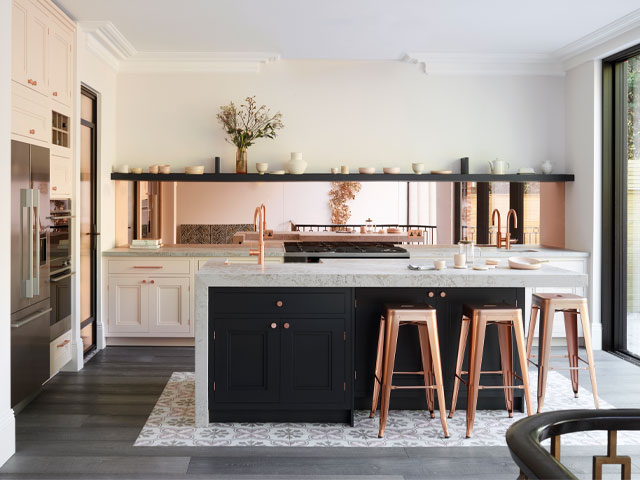
mixed material kitchen: pink metallic splashback with marble island
How to use mixed materials in a kitchen
Play with eye-catching surfaces and textures to nail the mixed material kitchen trend. Eclectic decor has become a key look this year, in part down to homeowners seeking to inject more fun into their decor after bring stuck indoors for so long during the pandemic.
But it’s not just about aesthetics. As our kitchens have become more multifunctional, using different materials is also a great way to zone spaces for flexible living. Here’s how to shake up your scheme with mixed materials…
1. Marble takeover
Sometimes it pays to choose one real showstopper of a material and let it take centre stage. Here, super-chunky Breccia Vagli marble adds glamour and interest with its unique veining. Stone isn’t just reserved for worktops and splashbacks either; to really show it off, the sink and island unit have also been crafted from the same marble, heightening the sense of drama. To let your hero material sing, don’t overdo the rest of the scheme. The designer chose a palette of black-stained oak and smoked glass to work as a backdrop and add contrast. Marble has a hefty price tag, but a similar look could be achieved with quartz or a composite surface. Kitchens by Paul start from around £42,000. For a similar marble finish, try the Arabetto quartz worktop in 5171, from £550 per sqm, Caesarstone.
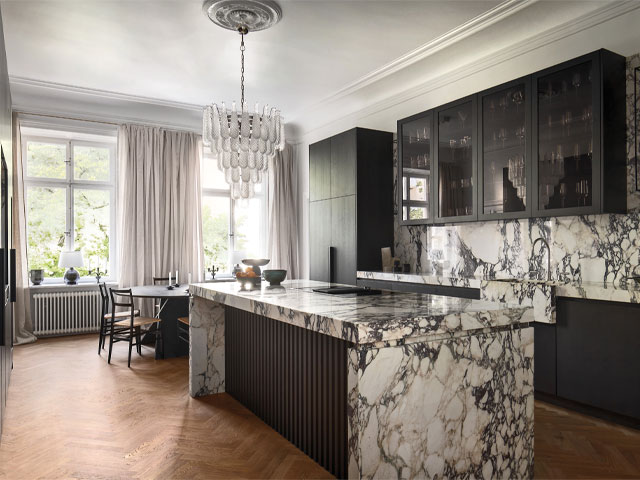
Breccia Vagli marble with black-stained oak and smoked glass. Photo: @kronfoto / @kitchensbypaul
2. Add metallic accents
Details can make all the difference to the overall look and feel of your kitchen, so really consider how all the elements work in harmony together. This mixed material kitchen design was driven by the homeowners’ love of pink and copper, so an eye-catching antique-bronze mirrored splashback was chosen to reflect light into the space, while metallic details on the handles, hinges and taps enhance the look. The Excava composite worktops and floor tiles around the island were chosen as they have pink tones that compliment the copper details and blush-coloured cabinetry. Metro and Classic cabinets in Farrow & Ball’s Pink Ground and Hague Blue. Unistone Cararra Misterio worktop and antique-bronze mirror splashback. Roundhouse kitchens start from £30,000.

Antique-bronze mirrored splashback with metallic handles, hinges, composite worktops and cabinets in Farrow & Ball’s Pink Ground and Hague Blue. Photo: Roundhouse
3. Blend old and new
To give a new kitchen character, try mixing contemporary elements with traditional styles. In this utilitarian-style kitchen the slick quartz worktop and glossy vintage-look metro tiles contrast nicely with the exposed brickwork and chunky oak butcher’s block worktop and open shelving. The industrial-style cookerhood and large range complete the look, with copper hardware adding that finishing touch. Original kitchen cabinetry in Farrow & Ball’s Studio Green and worktops in Quartz Bianco Massa and Wood Wide Stave End Grain Oak. Prices start from £25,000, Harvey Jones.
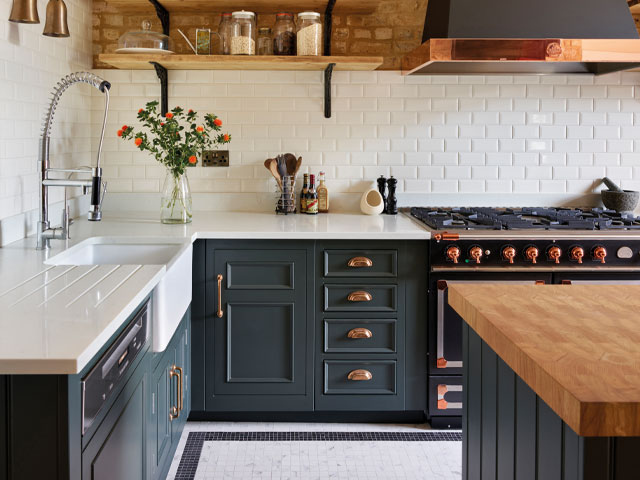
A slick quartz worktop and glossy metro tiles contrast with exposed brickwork, oak butcher’s block worktop and open shelving. Photo: Harvey Jones
4. Rough with the smooth
If you like a more minimalist look, you can still experiment with textures to add interest to your kitchen. Working with a neutral or earthy palette creates depth while keeping the space crisp. Using a striking granite splashback and resilient quartz worktop adds a natural touch to this kitchen and softens the look, while blending matt and gloss surfaces allows light to play across the mixed material kitchen in different ways. Natural light will bounce off slick appliances and glass surfaces, creating impact and drawing the eye to it while reflections on cabinetry surfaces add a more ambient glow. Ultimately, these small considerations can make a room seem brighter and more spacious. Lava Matt, Sepia Gladstone Oak and Venezia made-to-measure Truffle Brown Denver Oak cabinetry with Dekton worktops in Keyla and Trilium. The Luxe kitchen starts from £30,000, Life Kitchens.
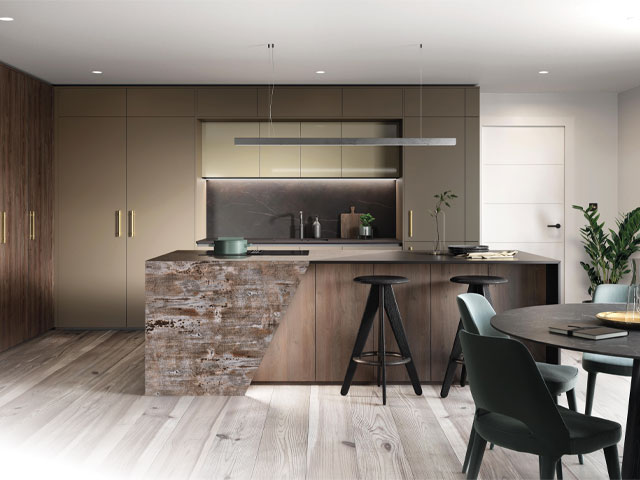
A granite splashback and quartz worktop combine with matt and gloss surfaces for a natural look with added interest. Photo: Life Kitchens
5. Switch up your worktops
There are many benefits to mixing your worksurfaces, allowing you to get the best of both worlds both practically and aesthetically. Stone and composites can be more expensive, so introducing timber into one area of the room is a budget-friendly compromise to help cut costs, plus timber adds warmth and texture to prevent a scheme feeling cold. However, wood tends to need more upkeep, so it’s best reserved for light-use areas such as breakfast bars, while stone and composites are relatively maintenance free, making them great for busy family kitchens. Elmbridge cabinetry in Dusk Blue with Marble-effect Suede Quartz worktop in Light Grey and Square Edge Solid Wood worktop in oak, POA, Howdens.
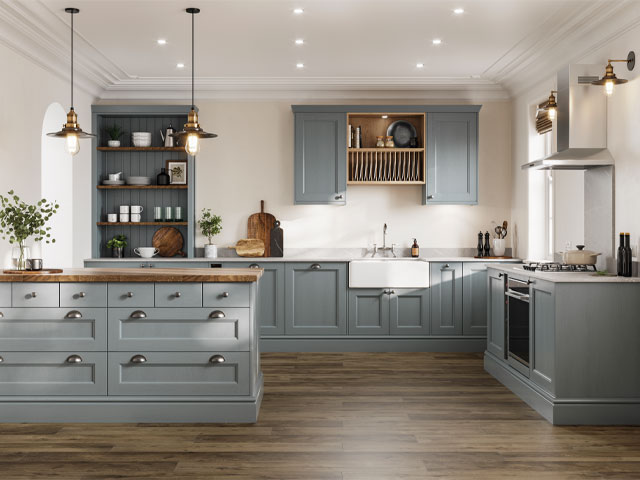
Stone and composites can be expensive, so mixing your worksurfaces and introducing some timber can cut costs and add texture. Photo: Howdens
TOP TIP: If you want a mixed material kitchen but don’t have a huge budget, a cost-effective option is laminate that can mimic the look of real stone or wood. Plus it’s hygienic thanks to its plastic coating, as well as resistant to heat, water damage and everyday scuffs.
6. Statement splashback
Tiles are a great way to add further interest to a scheme, especially those with textured surfaces, unusual shapes or gloss finishes. Look for a contrasting splashback to your units, so opt for tiles with a glaze or handmade finish if you have matt cabinets, or perhaps choose an ultra-matt tile with a pattern or different shape if you have gloss or eggshell cabinets. Take into account your worktop too, as that will be sitting in close proximity – again, look to add another dimension, so if you have a light stone top, perhaps use darker tiles. Alexa Hex porcelain tiles in Blush Pink, £52.80 per sqm, Tile Giant.
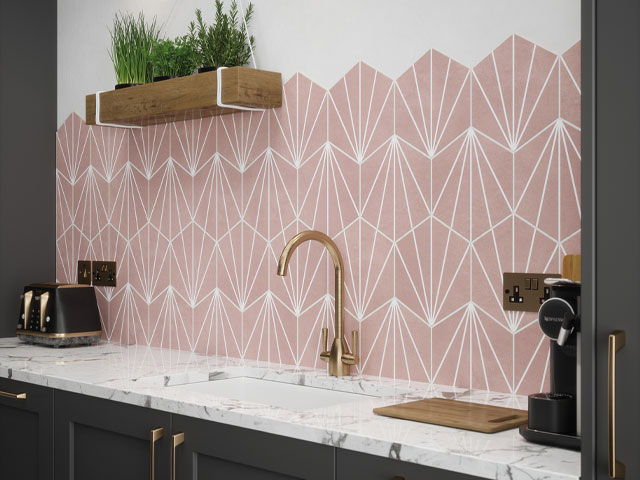
Look for a splashback or tiles that contrast your kitchen cabinets to add interest. Photo: Tile Giant
7. Inject colour
Choose materials that work in harmony with your colour palette and enhance it for a rich and textural scheme. The oxidation on this striking splashback accentuates the teal cabinetry, while the mauve units blend in with the pink-toned metal. It’s not just a statement piece either; the copper is lacquered with a non-porous coating to seal in the finish, plus it naturally has antibacterial properties, making it a practical choice as well as good-looking. In-frame Slab doors in Pierhouse and Wild Heather with oxidised copper splashback. Naked Kitchens start from £18,000.
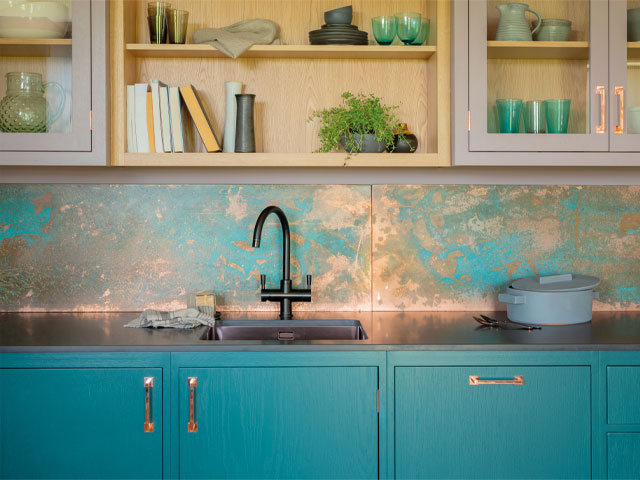
The oxidation on this striking splashback accentuates the teal cabinetry. Photo: Naked Kitchens
TOP TIP: When choosing your palette of mixed materials, sometimes it’s best to stick with a family of tonal shades to keep the scheme calm and uncluttered, especially if it’s a small space
8. Mix and match
When you’re working with a compact kitchen or an open-plan space, a mixed material kitchen design that offers a pick-and-mix range for its cupboard fronts is a great idea. In this apartment, light wood-look cupboards are used above the dark base units and the same timber finish for the peninsula to create a perception of openness and space, making the kitchen seem bigger than it is. Choosing a versatile cabinet collection also means you can easily combine coordinating furniture such as media units and bookcases to bring the whole space together, but allowing you to utilise the different finishes on offer for a less one-dimensional look. The Arcos Mix collection includes 29 colours and finishes; shown is Caneo and Harvey wood finish. The laminate worktops are in Caneo and Blackwood. Schmidt kitchens start from £10,000 including delivery and fitting.
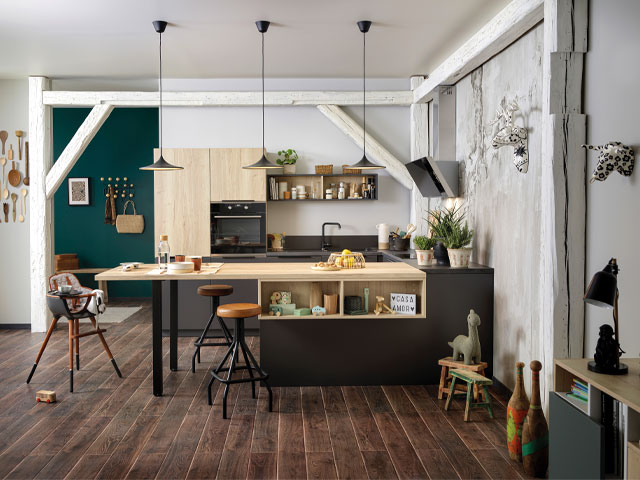
Light wood-look cupboards above dark base units create a perception of openness and space. Photo: Schmidt
9. A touch of glass
Too many solid slab doors can become oppressive, so try using glazed doors to break up a bank of wall units and add another dimension to your scheme. Reeded glass is a popular choice; not only is it semi-transparent, meaning you don’t have to be overly fussy about arranging its contents so it looks neat – it also delivers an interesting textural quality, which is key in a pared-back contemporary mixed material kitchen. Here, timber-backed open shelving also enhances the sense of openness and adds warmth. The Hunton kitchen in Putty with Soho handles in Matt Black, from £15,000, Second Nature.
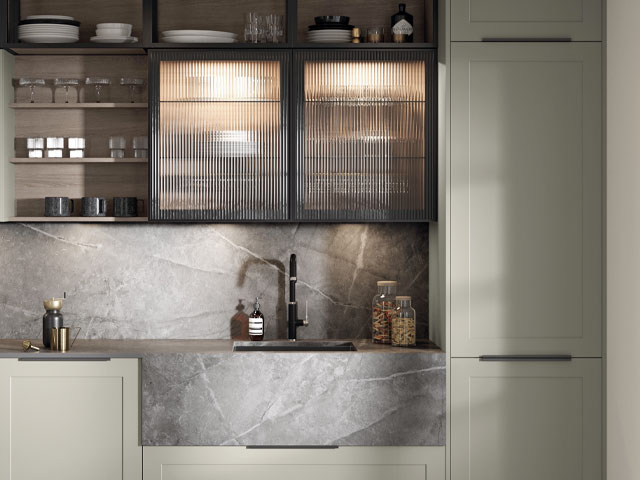
Break up a bank of wall units with open shelving and reeded glazed doors. Photo: Second Nature
PLANNING A MIXED MATERIAL KITCHEN
Jayne Everett, creative director at Naked Kitchens, on where to start when planning a new kitchen…
“When combining various materials the design needs to be carefully thought through and it pays not to over-complicate the use of different finishes. Small touches of a certain finish dotted through the space can start to look bitty.”
Everett suggests it’s better to examine your day-to-day tasks as a starting point for your material choices. The kitchen is the hub of the home and isn’t just for cooking, but also for entertaining, relaxing and working, so take that into consideration when planning your design.
Highly durable finishes such as quartz, solid-surface, or ultra-compact worktops are ideal for heavy-use areas as they are smooth, easy to wipe down, and very resilient to heat and scratches. A wooden worktop will add warmth but is a soft material, which can become scratched or scorched during food preparation. Confine the use of wood to soft-use areas such as a breakfast bar for eating, working or entertaining.
“We’re also seeing an interest in fluted timber, especially this year. This does look great, however it’s not so practical in a kitchen environment where regular cleaning needs to be considered, so think about its proximity to the cooking area.”





